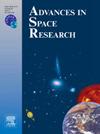基于Sentinel-2时间序列数据的薰衣草物候特征鉴定与制图
IF 2.8
3区 地球科学
Q2 ASTRONOMY & ASTROPHYSICS
引用次数: 0
摘要
薰衣草不仅具有观赏价值,而且具有显著的经济效益和生态效益。特别是在西北干旱地区,薰衣草在环境保护、退耕还林还草、防止风蚀等方面发挥着至关重要的作用。此外,薰衣草产业已成为新疆伊犁哈萨克自治州区域经济发展的重要组成部分。因此,快速准确地获取薰衣草种植信息对于促进该地区薰衣草产业的长期发展至关重要。本研究利用高分辨率Sentinel-2卫星影像,结合Savitzky-Golay滤波法重构的NDVI和RENDVI783时间序列数据,提取薰衣草7个关键物候特征。采用袋外误差法优选这些特征,并在此基础上构建了6种不同的分类方案。将这些方案与随机森林、决策树和最大似然分类三种机器学习模型相结合,探讨它们在薰衣草遥感识别研究中的适用性。结果表明:NDVI和RENDVI783时间序列植被指数在薰衣草生长季表现出一致的趋势,从4月的苗期到5月初的盛花期显著增加,在6月下旬至7月的开花期达到峰值;虽然在RENDVI783时间序列中峰值较低,但作物之间的差异更明显,物候特征也更清晰。物候特征如振幅(Amplitude)、基数(Base)、中点(Midpoint)和最大值(Max Value)在OOB选择中得分在0.20以上,因此被认为是关键变量,并纳入后续的分类实验。在所有分类方案中,采用RENDVI783与物候特征最优选择方案F的分类准确率最高,其中随机森林模型(Random Forest model, RF-F)的总体准确率为93.21%,Kappa系数为89.98。决策树(DT-F)和最大似然分类(MLC-F)方法的总体准确率分别为92.41%和90.68%,Kappa系数分别为88.86和86.02。研究结果为薰衣草等作物种植信息的快速、精确提取提供了新的见解和参考。本文章由计算机程序翻译,如有差异,请以英文原文为准。
Identification of phenological characteristics and mapping lavender using Sentinel-2 time series data
Lavender not only has ornamental value but also significant economic and ecological benefits. Particularly in the dry areas of Northwest China, lavender plays a vital role in environmental protection, returning farmland to forest or grassland, and preventing wind erosion. Additionally, the lavender industry has become an integral part of the regional economic development in the Yili Kazakh Autonomous Prefecture, Xinjiang. Therefore, rapidly and accurately obtaining lavender planting information is vital for fostering the long-term growth of the lavender industry in the region. This study utilized high-resolution Sentinel-2 satellite imagery combined with NDVI and RENDVI783 time series data reconstructed using the Savitzky-Golay filtering method to extract seven key phenological features of lavender. The out-of-bag (OOB) error method was used to optimally select these features, and based on this, six different classification schemes were constructed. These schemes were integrated with three types of machine learning models—Random Forest, Decision Tree, and Maximum Likelihood Classification—to explore their applicability in remote sensing identification studies of lavender. The results showed that NDVI and RENDVI783 time series vegetation indices displayed consistent trends during the lavender growing season, with a significant increase from the seedling stage in April to the peak blooming period in early May, reaching a peak during the flower-belling period from late June to July. Although the peak values in the RENDVI783 time series were lower, the distinction between crops was more apparent, and the phenological features were clearer. Phenological features such as Amplitude, Base, Midpoint, and Max Value scored above 0.20 in the OOB selection, thus were considered key variables and included in subsequent classification experiments. Among all classification schemes, the combination of RENDVI783 and optimally selected phenological features (Scheme F) achieved the highest classification accuracy, where the Random Forest model (RF-F) achieved an overall accuracy of 93.21% and a Kappa coefficient of 89.98. The Decision Tree (DT-F) and Maximum Likelihood Classification (MLC-F) methods had overall accuracies of 92.41% and 90.68%, with Kappa coefficients of 88.86 and 86.02, respectively. The research results provide new insights and references for the rapid and precise extraction of planting information for crops such as lavender.
求助全文
通过发布文献求助,成功后即可免费获取论文全文。
去求助
来源期刊

Advances in Space Research
地学天文-地球科学综合
CiteScore
5.20
自引率
11.50%
发文量
800
审稿时长
5.8 months
期刊介绍:
The COSPAR publication Advances in Space Research (ASR) is an open journal covering all areas of space research including: space studies of the Earth''s surface, meteorology, climate, the Earth-Moon system, planets and small bodies of the solar system, upper atmospheres, ionospheres and magnetospheres of the Earth and planets including reference atmospheres, space plasmas in the solar system, astrophysics from space, materials sciences in space, fundamental physics in space, space debris, space weather, Earth observations of space phenomena, etc.
NB: Please note that manuscripts related to life sciences as related to space are no more accepted for submission to Advances in Space Research. Such manuscripts should now be submitted to the new COSPAR Journal Life Sciences in Space Research (LSSR).
All submissions are reviewed by two scientists in the field. COSPAR is an interdisciplinary scientific organization concerned with the progress of space research on an international scale. Operating under the rules of ICSU, COSPAR ignores political considerations and considers all questions solely from the scientific viewpoint.
 求助内容:
求助内容: 应助结果提醒方式:
应助结果提醒方式:


